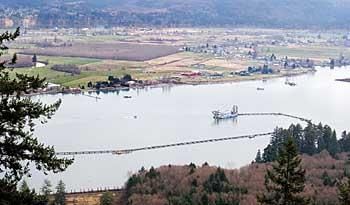forum
library
tutorial
contact

Columbia River Deepening
Sparks $1 Billion in Investments
by Marissa Luck
The Daily News, June 27, 2015
|
the film forum library tutorial contact |

|
Columbia River Deepening
by Marissa Luck
|
 Despite criticism from environmentalists, the $200 million Columbia River channel deepening project generated over $1 billion in capital investments since its completion five years ago, port officials and terminal operators say.
Despite criticism from environmentalists, the $200 million Columbia River channel deepening project generated over $1 billion in capital investments since its completion five years ago, port officials and terminal operators say.
In a new report released by Port of Portland and Pacific Northwest Waterways Association, consultants studied the economic impact of the project that deepened the Columbia River from 40 to 43 feet.
"The Columbia River Channel Improvement Project is the perfect example of how to make smart infrastructure investments and proves that if you build it, they will come," Kristin Meira, Executive Director of PNWA, said in a prepared statement. "In just five years, we've seen more investment on the lower river than any of us could have imagined."
Proponents say that a bevy of capital investments made in the past five years likely wouldn't have happened if the U.S. Army Corps of Engineers hadn't deepened the river.
In Cowlitz County, those capital projects include:
Although it only took a few years to deepen the channel, it took 20 years of study and political fighting to get the project authorized and funded after the ports of Longview, Kalama, Woodland, St. Helens, Portland and Vancouver first asked the Corps to study the feasibility of the project in 1989.
Supporters argued the project makes the region more competitive, especially as a project to double the capacity of the Panama Canal is slated for completion in 2016. Deepening also provided investors with certainty that the river would have enough capacity to handle increasingly larger ships, the report suggests.
But Nina Bell, executive director of the Portland-based Northwest Environmental Advocates, slammed the report for failing to look at the environmental costs associated with channel deepening. Bell argued that it will cost taxpayers millions of dollars to control the environmental degradation associated with dredging.
"The amount to repair the jetties as they're falling apart, and dealing with the erosion, those are going to be issues that we have to deal with ... We're asking tax payers across the country to pay for something that doesn't make sense," Bell said Friday.
"So big-picture, anytime that someone does an economic evaluation without looking at those costs, it is frankly useless and just sort of horn-tooting," she added.
Northwest Environmental Advocates sued the Corps and the National Marine Fisheries Service over the project, pointing to studies suggesting that dredging would release toxins in the water, damage critical wildlife habitat and exacerbate erosion. They also claimed that the Corps exaggerated the economic benefits of the project.
Eventually all of the lawsuits and appeals were dismissed, although some concessions were made. To compensate for dumping dredging materials, the Corps agreed to 736 acres of environmental mitigation work, and another 4,000 acres of restoration work for riparian and wetland habitats.
Related Pages:
Impacts of Channel Deepening on the Columbia River by ECONorthwest, June 2015
learn more on topics covered in the film
see the video
read the script
learn the songs
discussion forum
